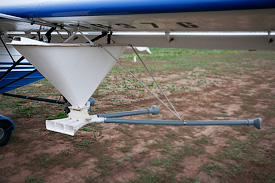The time of seeding plays a special role among other factors that influence plants development and productivity. Seeding cereal and other crops in the most appropriate farming periods guarantees their higher yielding capacity. However, due to excessive moisture in the soil, it might be difficult to meet deadlines while seeding with ground seeders. So, aviation may lend a helping hand here.
The world practice of broadcast seeding shows that aviation has been employed for this type of work for over half a century.
The first aerial seeding was done with rice seeds in Southern California as early as 1929. At first this method did not become common use due to low efficiency of the aircrafts and lack of special equipment. However, later on aerial seeding was applied on a significantly larger scale. Studies conducted by a number of research facilities to reveal prospects for aerial seeding found such benefits as high efficiency of the equipment which consequently shortens seeding time and releases sought-after labor force.
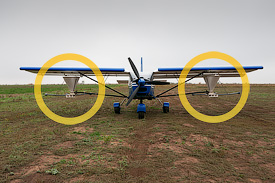
Aerial seeding of cereal grains (rye, wheat, and barley) is wide-spread in Germany, of rice – in the US, and of perennial crops (such as clover and alfalfa (or lucerne)) – in New Zealand and Australia. Application of aerial seeding in different countries has demonstrated advantages of this method in fighting soil erosion and regenerating grass cover on hay-fields and grazing lands.
Russia, the North Caucasus in particular, and Ukraine have applied aerial seeding of grain crops and perennial grass crops on wet soils since 1932. With the development of aircrafts and seeding equipment the aerial seeding technics for various crops improved and new ones appeared.
Studies conducted by the Russian Research Institute of Civil Aviation in Agriculture (VNII PANH GA) in cooperation with other research institutes allowed for the development of aerial seeding technology for grain crops, rice, and perennial grass crops with the Antonov An-2 aircraft equipped with tunnel sprayers, which were later modified into wide coverage tunnel sprayers RTSh-1, RTSh-1M, RTSh-1B. Another variation was a helicopter Ka-26 with an axial sprayer, or a helicopter Mi-2 equipped with a serial tunnel sprayer. To conduct aerial seeding of small-seeded crops a special micro-feeder for RTSh-1B was designed.
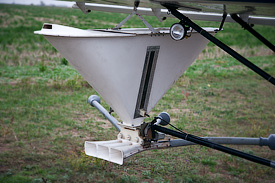
For the last decade, due to some economic reasons (high cost of aerial work and insolvency of many farmers) aerial seeding in Russia has not been in high demand. Nevertheless, at present aerial seeding is becoming more widely adopted due to the improving economic situation in the country and introducing new agricultural crops.
Aircrafts AN-2 and Mi-2 are still employed in aerial seeding of cereal grains and rice with large seeding rates.
The research and development company Application of Aviation in Farming” (legal successor of VNII PANH GA) is conducting research in prospective application of ultralight aircrafts for aerial seeding of small seeded crops with low seeding rates, which is significantly cheaper for this type of work. For example, in 2007, research was carried out on the territory of Antonovskoye LLC (OOO) (Antonov village, Oktyabrskiy district, Volgograd region) headed by Mikhail Yu. Derevyanko.
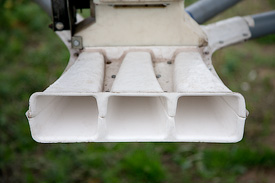
Seeds of mustard Sareptskaya (subspecies of Indian mustard, Brassica juncea) were used in that project. In accordance with previous experience, the highest yield of this plant can be achieved only through early and extra early seeding time, especially when the soil is very wet. The latter condition is of particular importance because seeds imbibition and germination require a large amount of water. While the aerial seeding can be carried out regardless the soil condition, the developing of aerial mustard seeding technology is promising and beneficial.
The experiment implied studying the efficacy of aerial seeding of mustard and establishing optimal operating norms for this type of work (seeding rates, working width, speed and height of flying). The working width was determined with due regard to the seeds’ aerodynamic properties, wind direction and speed.
The aerial seeding experiment involved the aircraft SP-30 (СП-30) equipped with the aerial seeder SA-34 (СА-34) developed by Vladimir V. Lygin (Volgograd), while the land seeding experiment involved a DT-75M tractor (ДТ-75М) equipped with an SZT-3,6 (СЗТ-3,6) seeder.
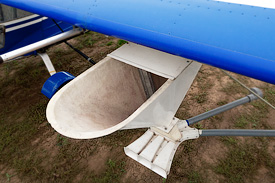
The aerial seeding was conducted over a thawing soil (soil moisture was 95% of the lowest moisture capacity) at the temperature of −2°С. The agricultural methods complied with the regional best practices. The aerial seeding was done in an early agricultural period (early April) on a prepared soil. After the aerial seeding was completed, the seeds were rolled down into the soil. The land seeding was conducted two weeks later with simultaneous seeds rolling.
The flying speed was 100 km/hour, at the height of 10-15 meters; the working width was 14-17 meters.
The test flights for the purpose of developing operating procedures were conducted in compliance with the SP-30 aircraft Operating Manual, SA-34 aviation equipment Operating Manual, with regard to the USSR Civil Aviation Aerial Application Guidance, the Recommendations on Aerial Application in Agriculture and Forestry in the USSR, and other effective regulatory documents.
The distribution of seeds over the farming area was measured by weighing seeds that had fallen into metering devices (cones) with the area of 0.25 sq. meters. Twenty cones were installed at two meter intervals along one line perpendicular to the flight direction.
The discharge of seeds in the SA-34 seeding equipment was adjusted by a feeder (metering unit), which provides smooth adjustment of seeding rates up to 20 kg per hectare.
The analysis of planting and technical data revealed that for an SP-30 aircraft equipped with an SA-34 seeder the proper seeding rate for aerial works will be 6.5-7.5 kg/hectare (6-7 kg/hectare for land seeding), at the height of 12-15 meters and the working width of 15 meters.
The studies have found that regardless of the seeding method and the depth of seeding the evenness of mustard shoots was quite high.
The experiments conducted in favourable weather conditions in the spring and summer vegetation seasons provided mustard yield of 2000 kg/hectare after aerial seeding and up to 1000 kg/hectare after land seeding. This yield capacity is subject to optimal seeding time and proper seed distribution.
Thus, the results of the experiment confirm the efficacy of applying the SP-30 aircraft for aerial seeding of mustard allowing good quality and high performance seeding in early season.
Over thirty thousand hectares was seeded with small-seeded oil crops by SP-30 aircrafts equipped with SA-34 in the Volgograd, Saratov, Rostov and Penza regions, and the Republic of Kalmykia. The yield capacity of mustard would reach 19,000 kg/hectare subject to favourable conditions.
